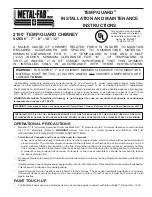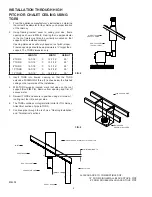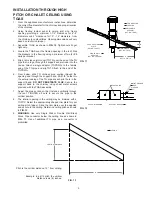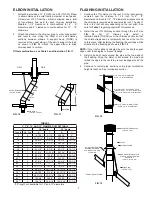
2100
°
TEMP
/
GUARD CHIMNEY
SIZES 6” - 7” - 8” - 10” - 12”
TEMP/GUARD
®
INSTALLATION AND MAINTENANCE
INSTRUCTIONS
This symbol on the nameplate
means this product is listed by
Underwriters Laboratories Inc.
Listing No. MH 8251
Tested to 103 HT
A MAJOR CAUSE OF CHIMNEY RELATED FIRES IS FAILURE TO MAINTAIN
REQUIRED CLEARANCES (AIR SPACES) TO COMBUSTIBLE MATERIAL.*
MINIMUM CLEARANCE FOR 6” - 8” TEMP/GUARD IS ONE AND A HALF
(1-1/2) INCHES. MINIMUM CLEARANCE FOR 10” - 12” TEMP/GUARD IS
TWO (2) INCHES. IT IS OF UTMOST IMPORTANCE THAT THIS CHIMNEY
IS INSTALLED ONLY IN ACCORDANCE WITH THESE INSTRUCTIONS.
WARNING:
FOR SIZES 6”, 7” & 8” CHIMNEY, MINIMUM CLEARANCE TO COMBUSTIBLE
MATERIAL MUST BE TWO (2) INCHES UNLESS ALL CHIMNEY COMPONENTS ARE
LABELED
TG MAX
.
*Combustible material is defined as material made of, or surfaced with, wood, compressed paper, plant fibers,
plastic, or other material that will ignite and burn, whether flame proofed or not, or whether plastered or unplastered.
The Metal-Fab Temp/Guard Chimney is intended for use on any residential and building heating appliance burning gas,
liquid or solid fuels such as fireplace stoves, furnaces, ranges, room heaters, or as defined in columns I and II, Table
2-2.1, NFPA 211. Contact Local Building or Fire Officials about restrictions and Installation Inspection in your area.
WARNING: Metal-Fab Temp/Guard Chimney is not designed for use on products that operate at continuous
temperatures in excess of 1,000°F.
WARNING: If decorative shrouds are being used with Temp/Guard Chimney, Reference the Temp/Guard Addendum L2372.
IMPORTANT: FOR OIL OR COAL BURNING APPLIANCES, OUTSIDE THE ENVELOPE OF THE BUILDING, USE ONLY PIPE WITH
STAINLESS STEEL CASING, ALSO USE FLASHING OR STORM COLLARS CONSTRUCTED OF STAINLESS STEEL OR ALUMINUM.
OPERATIONAL PRECAUTIONS
•
Maintain 1-1/2” minimum clearance to combustibles for 6”- 8” diameters and 2” minimum clearance to combustibles
for 10”-12” diameters (Refer to
WARNING
above). Use only U.L. Listed products and INSTALL ONLY IN
ACCORDANCE WITH MANUFACTURER’S INSTRUCTIONS.
•
Formation of Creosote and Soot and the need for removal.
When wood is burned slowly, it produces tar and other organic vapors, which combine with expelled moisture to
create creosote. The creosote vapors condense in the relatively cool chimney flue of the slow burning fire. As a
result, creosote residue accumulates on the flue lining. When ignited, this creosote makes an extremely hot fire.
The chimney should be inspected at least once every two (2) months during the heating season to determine if
a creosote or soot buildup has occurred. If creosote or soot has accumulated, it should be removed to reduce
the risk of chimney fire.
•
Do not use fireplace for food grill. Grease from foods can collect in chimney causing fireplace to become a potential fire
hazard.
•
On airtight stoves, open dampers and let equipment burn hot for 15 to 20 minutes. This should be done every time fuel is added.
This lessens the chance of creosote buildup.
•
Some chemical chimney cleaners can be harmful to the chimney. These cause accelerated oxidation or corrosion.
If chemical cleaners are used, they must be non-corrosive in nature. If brush is used, it must be of proper size with
plastic bristles.
PAINT TOUCH-UP
•
The flat-black paint used on painted parts may be touched up,as required, with Stove Bright
®
Product No. 1990.


























